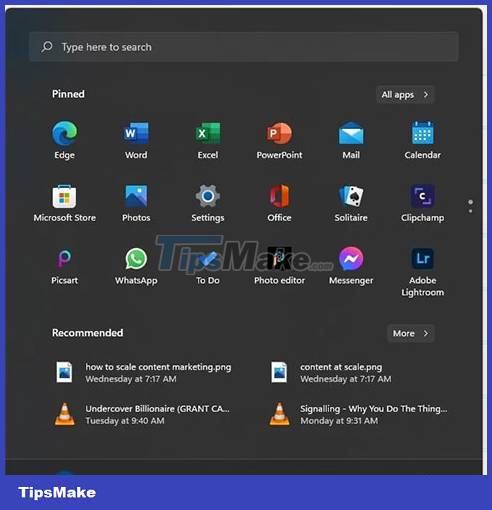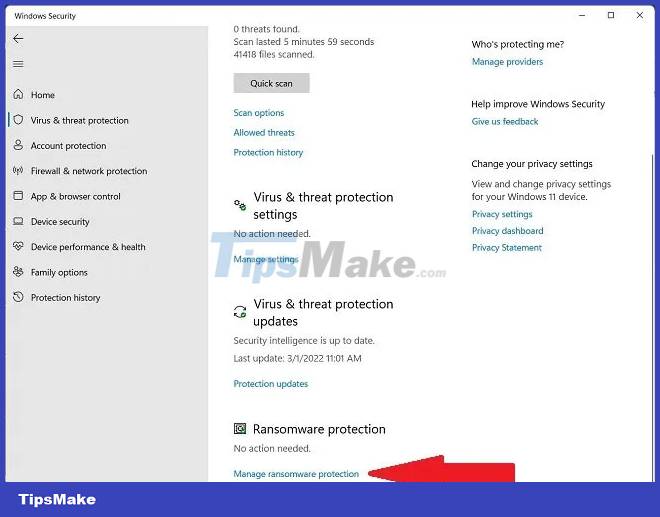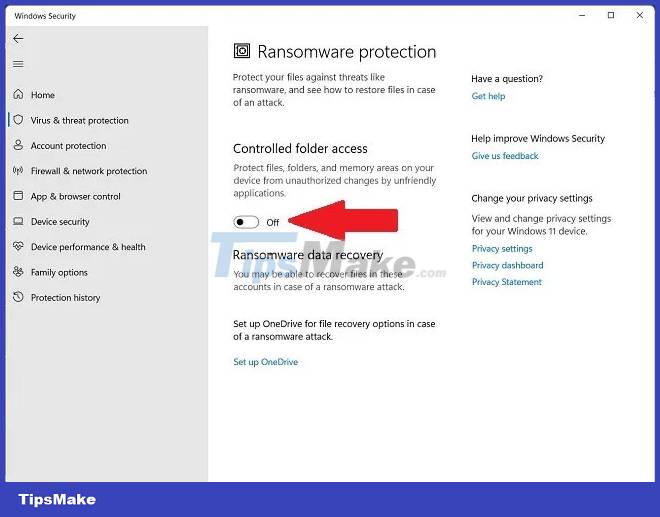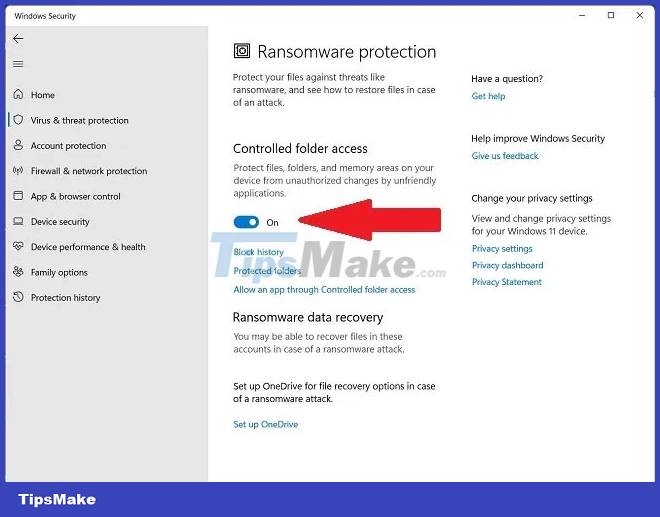How to enable Ransomware Protection on Windows
However, by default, this anti-ransomware protection is disabled on all Microsoft devices. Let's discover how to enable this feature in the privacy settings through the following article!
How to enable Ransomware Protection in Windows 11
Before making these changes, make sure you are using an admin account. Guest accounts do not have access to this feature.
Step 1. Click the Win button and scroll down to the Start menu to find the Settings tab. Click it to open the Settings menu.
Another way is to look for the Settings icon on the pinned items or use the search bar to find 'Settings'.

Step 2. When the Settings tab launches, select Privacy & Security .

Step 3. Find the Windows Security menu.

Step 4. Click the Open Windows Security button to access the ransomware settings.

Step 5. A new window will open. Here, click on the Virus & Threat, Protection menu item and scroll down to find the Ransomware Protection option .

Step 6. Click Manage Ransomware Protection to get a list of options related to ransomware.

Step 7. Find the Controlled Folder Access option in the right pane.

Step 8. Toggle the switch to enable the feature.

Ransomware Protection is now enabled. Here you can also add (whitelist) the program folders that can give incorrect warning results in protected folders.
How to use a PC with Ransomware Protection enabled
Once the Ransomware Protection feature is enabled, you will have to whitelist some of your favorite programs in order for them to gain controlled folder access. These steps will help you avoid false authentication and allow the installation of new programs:
Step 1. Click Allow an app through Controlled folder access in the Controlled Folder Access window .

Step 2. Click Add an allowed app .

Step 3. Select Browse all apps or Recently blocked apps to see if Windows Security (formerly known as Windows Defender) has been cached or blocked.

Step 4. Choosing Browse all apps will open a pop-up window allowing you to select all executable files with .exe extension.
Step 5. In Recently Blocked Apps , you can delete harmful or unwanted apps or restore the ones you want to keep.

To avoid mistakenly flagging useful software or applications as ransomware, add them to the Protected Folders section.
You should read it
- 7 kinds of ransomware you didn't expect
- [Infographic] 7 effective ways to protect businesses from Ransomware
- What is Ransomware Task Force (RTF)?
- Can a VPN Protect You From Ransomware?
- No anti-virus software can detect this extremely dangerous new Ransomware on Android
- List of the 3 most dangerous and scary Ransomware viruses
- Detect and prevent Ransomware with CyberSight RansomStopper
- Protect your computer right before the return of two extremely dangerous ransomware
May be interested
- Compare Microsoft Defender and Bitdefender
 microsoft defender is microsoft's default security solution for windows 10 and 11. this option is good enough for most users, as it has dramatically improved threat detection and features over the years. via.
microsoft defender is microsoft's default security solution for windows 10 and 11. this option is good enough for most users, as it has dramatically improved threat detection and features over the years. via. - What is SquirrelWaffle malware? How to avoid?
 called dropper malware, the developers of squirrelwaffle have gone to great lengths to keep it hard to detect and analyze.
called dropper malware, the developers of squirrelwaffle have gone to great lengths to keep it hard to detect and analyze. - What is rooting malware? What can you do to protect yourself?
 rooting malware works by gaining root access to the victim's phone. this gives the malware more control over the phone.
rooting malware works by gaining root access to the victim's phone. this gives the malware more control over the phone. - Review Kaspersky Internet Security 2021: A comprehensive set of security tools for computers
 kaspersky internet security 2021 is a premium single-license multi-utility security suite that protects against malware, phishing, and ensures safe browsing. this multi-layered security software keeps your important data safe on the internet.
kaspersky internet security 2021 is a premium single-license multi-utility security suite that protects against malware, phishing, and ensures safe browsing. this multi-layered security software keeps your important data safe on the internet. - What is Epsilon Red Ransomware?
 a new ransomware threat, called epsilon red, targets unpatched microsoft-based servers in enterprise data centers.
a new ransomware threat, called epsilon red, targets unpatched microsoft-based servers in enterprise data centers. - Causes and signs to identify a computer infected with Virus
 what to do when the computer is infected with a virus? signs that your computer is infected with a virus? share experiences and tips to know if your computer is infected with a virus or not and how to handle the virus 100% successfully
what to do when the computer is infected with a virus? signs that your computer is infected with a virus? share experiences and tips to know if your computer is infected with a virus or not and how to handle the virus 100% successfully






 Acronis Ransomware Protection, a completely free anti-ransomware solution for Windows
Acronis Ransomware Protection, a completely free anti-ransomware solution for Windows How to use Acronis Ransomware Protection against ransomware
How to use Acronis Ransomware Protection against ransomware How to enable ransomware restrictions on Windows
How to enable ransomware restrictions on Windows Enable ransomware Controlled Folder Access on Windows 10
Enable ransomware Controlled Folder Access on Windows 10 How to enable Controlled Folder Access anti-ransomware feature on Windows 10/11
How to enable Controlled Folder Access anti-ransomware feature on Windows 10/11